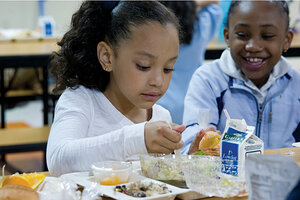Next on the feds' menu? Overhauling school lunches.
The Obama administration is trying to improve the nutrition of school lunch menus, and it's putting at least $4.5 billion behind it.

First-grader Tatyana Vicente eats her school lunch at the International Charter School in Pawtucket, R.I. The Obama administration is trying to overhaul the way the nation's children eat, starting with school lunch.
Alfredo Sosa/Staff
What kids eat – especially when they're in school – has never gotten more attention.
The first lady has made improving school lunches a central plank of her campaign to tackle childhood obesity. An ABC hit reality show had celebrity chef Jamie Oliver working with cafeteria workers in Huntington, W.Va., to chuck items like frozen breakfast pizzas from the menu and replace them with healthy, made-from-scratch alternatives.
Even the US military is drawing attention to kids' diets, with a study released in April by an officers' group showing that 27 percent of people aged 17 to 24 are too overweight to join the armed forces.
Now, the Obama administration is trying to make some of the biggest changes to the Child Nutrition Act – which governs the National School Lunch and School Breakfast programs – since it went into effect nearly a half century ago. A bill currently before the Senate would authorize $4.5 billion in new funding over 10 years, and the administration has outlined a proposal for twice that much.
"It's a recognition that we've learned more," says Tom Vilsack, the secretary of Agriculture. "Since most youngsters have the opportunity through the school system to have school breakfast or lunch, it's important to make sure what we provide adds to their nutritional well-being rather than be detrimental to it."
'Not just the vending machines'
The administration's proposal would give Secretary Vilsack the power, for the first time, to set nutrition standards for all food sold in a school building – even those in vending machines or an a la carte line. It's a change that many nutrition advocates say is needed.
"When you walk into a school – and certainly a high school – it's pervasive. Food is sold everywhere," says Tracy Fox, a food consultant in Washington. "It's not just the vending machines. A lot of the items in a cafeteria sold next to the school meal are very unhealthy choices." She has seen kids sit down with nothing but two doughnuts and Gatorade – bought at the school – for lunch.
The Department of Agriculture (USDA) plans to revise guidelines for school lunches to more closely match recommendations issued last fall by the Institute of Medicine: increase vegetables, fruits, and whole grains; limit sodium, calories, and fat.
In contrast to past years, there seems to be no significant opposition to the proposed changes from the food and beverage industry. But at a time when budgets are tight, finding ways to improve nutrition without increasing costs can be a challenge.
The Senate bill (which needs to be budget neutral) would add 6 cents to the $2.68 reimbursement rate that schools currently get from the federal government for free meals. The bill would also reduce some of the bureaucracy of the free-lunch program, which could make more money available to pay for food. But critics say the changes are not enough to pay for the fresh food and whole grains that should be in lunches.
"People say we really need a dollar extra," says Ms. Fox. "But it's still the biggest increase in reimbursement rates we've seen since the inception of the bill."
School lunches key
No one expects improving school lunches to solve the childhood obesity issue by itself, but it is a major component.
"Something like 90 percent of kids participate in a school meal during the school year – it's a huge number," says Rob Bisceglie, executive director of Action for Healthy Kids, which works with schools to address childhood obesity.
Despite the challenges, some schools are finding ways to get better food in front of kids.
For example, more than 2,000 "farm to school" programs in all 50 states work to connect schools with local farmers and produce – a model that would get new federal support under the proposed legislation.
Within the network, many schools and districts are coming up with innovative ideas to stress healthy eating, says Deb Eschmayar, outreach director for the National Farm to School Network. They include local apple tastings, students helping to harvest and freeze strawberries for use in smoothies throughout the year, and a "Ratatouille" party – complete with a showing of the Pixar film – at which a Wisconsin school community made and froze 50 gallons of ratatouille to eat during the winter.
In St. Paul, Minn., the reforms go beyond just getting local peppers, watermelon, and lettuce onto the menus. A new "choice bar" available to all students offers fruits, veggies, cottage cheese, and a variety of salads. The food staff is also introducing less-familiar items – including jicama, edamame, and portabellas – to the menu. The district even persuaded Sara Lee to begin selling schools whole-wheat buns for hamburgers and hot dogs next fall.
Not everything works. "Beets were a disaster," says Jean Ronnei, director of Nutrition & Commercial Services for the St. Paul Public Schools. But students embraced a "smart cookie" made with flax seed, shredded carrots, whole-grain flour, oatmeal, and a few chocolate chips.
"The idea is to expose them to a lot of different things," she says.
Related:
'Let's Move': Michelle Obama takes on childhood obesity
Michelle Obama says 'Let's Move' on obesity in American kids
Farm to School program has third-graders scrambling to the salad bar
